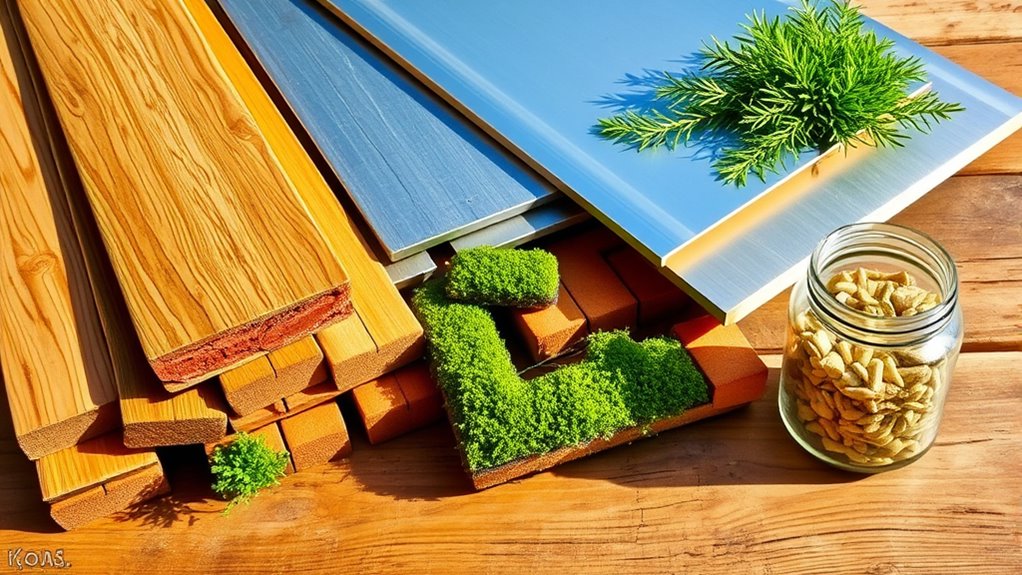For a comprehensive list of green building materials, consider plant-based options like hempcrete, bamboo, and mycelium for their excellent insulation properties. Recycled materials such as glass, steel, and reclaimed wood not only reduce waste but also enhance durability. Natural insulators like cork and sheep’s wool offer warmth and air purification. Plus, sustainable composites provide strength while minimizing environmental impact. Keep exploring to discover how each material can transform your construction projects.
Key Takeaways
- Hempcrete is a sustainable insulation material made from hemp fibers, sand, and lime, offering excellent thermal properties and carbon sequestration.
- Recycled materials such as glass, plastic, and steel enhance durability while reducing landfill waste and conserving natural resources.
- Natural insulators like cork, sheep’s wool, and straw excel in energy efficiency, fire resistance, and humidity regulation in sustainable construction.
- Bamboo and hemp are rapidly renewable resources with strong structural properties, suitable for various building applications and promoting soil health.
- Sustainable composites combine natural fibers with biodegradable matrices, providing high strength and reducing environmental impact while offering design flexibility for unique structures.
Plant-Based Materials
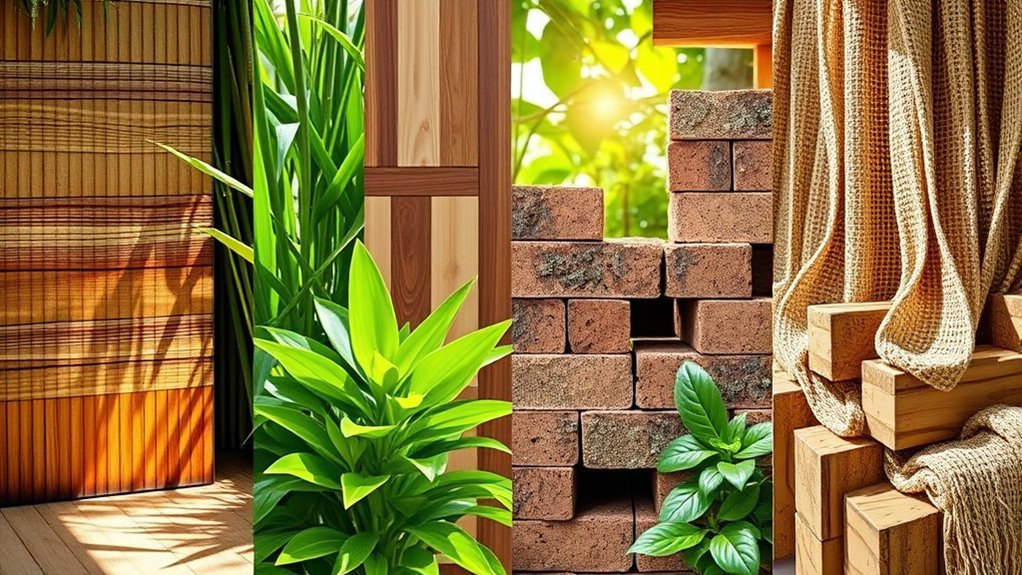
When it comes to sustainable construction, plant-based materials stand out as an innovative solution.
You’ll find options like hempcrete, which combines hemp fibers, sand, and lime for effective insulation. Plant-based polyurethane foam, made from bamboo and kelp, serves as excellent insulation for furniture and buildings. Mycelium, the root-like fibers of fungi, offers a biodegradable alternative while bamboo provides a strong, renewable structural option. Cork isn’t just recyclable; it’s also a fantastic insulator. Additionally, using these materials helps promote natural insulation and energy efficiency in buildings.
These materials not only reduce energy costs with their insulation properties but also lower carbon emissions. Plus, many are moisture and pest-resistant, making them practical choices for your next construction project.
Embracing plant-based materials promotes sustainability and conserves natural resources.
Recycled Materials
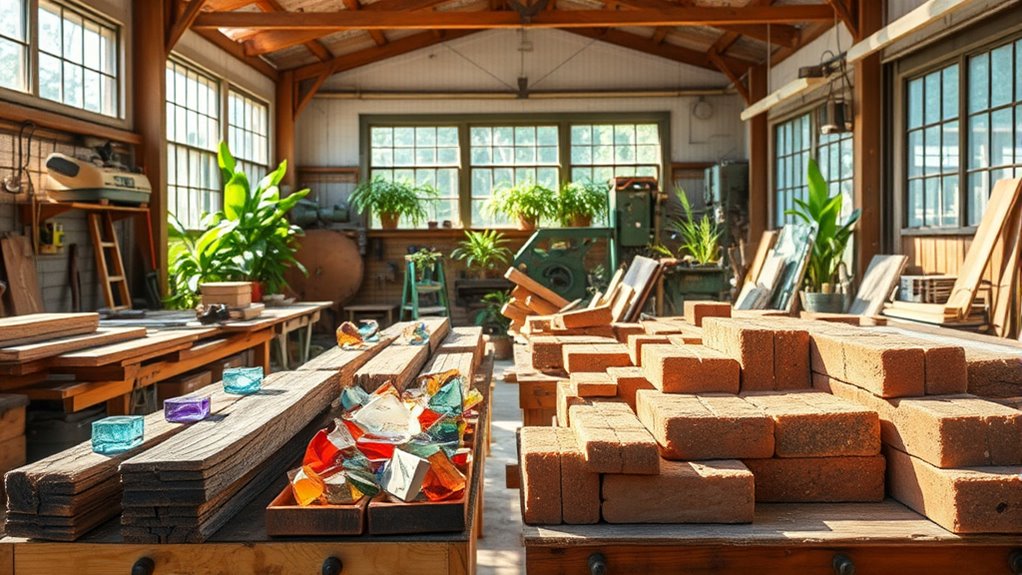
As the construction industry seeks to minimize its environmental footprint, recycled materials have emerged as a practical solution.
These materials, reused from waste products, help reduce landfill waste and conserve natural resources. By choosing recycled options, you not only decrease waste but also enjoy cost savings compared to virgin materials. For instance, materials like recycled glass, plastic, steel, and reclaimed wood can enhance durability and aesthetics. Projects like the EPA Potomac Yards Buildings showcase how effective these materials can be, achieving significant landfill diversion. The construction industry accounts for 39% of worldwide energy-related CO2 emissions, highlighting the importance of sustainable practices. Additionally, sustainable living encourages the use of innovative designs that incorporate recycled materials, further promoting environmental responsibility. Implementing advance directives in construction projects can also ensure that sustainability goals are prioritized throughout the project’s lifecycle.
Recycled materials minimize landfill waste, conserve resources, and offer cost-effective alternatives to virgin options.
Using recycled materials can also improve indoor air quality and offer unique design flexibility. For example, cotton candy grapes showcase how innovative approaches can enhance the appeal of products while supporting sustainability. Embracing these options fosters sustainability while benefiting the economy and environment alike.
Natural Insulators

Recycled materials have paved the way for innovative building solutions, and natural insulators are no exception.
You’ll find options like cork insulation, made from oak tree bark, providing an R-value of 3.6 – 4.2 per inch.
Sheep’s wool not only insulates with an R-value of 3 – 4 but also purifies the air, while the high fiber content in certain natural materials can also enhance indoor comfort. Additionally, baked kale is a great example of a plant-based option that retains essential nutrients, supporting a sustainable lifestyle. Natural insulators can also contribute to a significant reduction in greenhouse gas emissions, promoting healthier living environments.
Hemp insulation sequesters carbon during growth, while straw insulation excels in energy efficiency.
Novel materials like pineapple leaves and mushroom-based insulation are emerging too.
These natural insulators offer fire resistance and regulate humidity, enhancing indoor air quality. Additionally, eco-friendly materials contribute to a reduction in greenhouse gas emissions, supporting broader environmental goals.
However, keep in mind that some can be pricier and may require specialized installation.
Choosing natural insulators supports sustainability and reduces your carbon footprint.
Renewable Resources
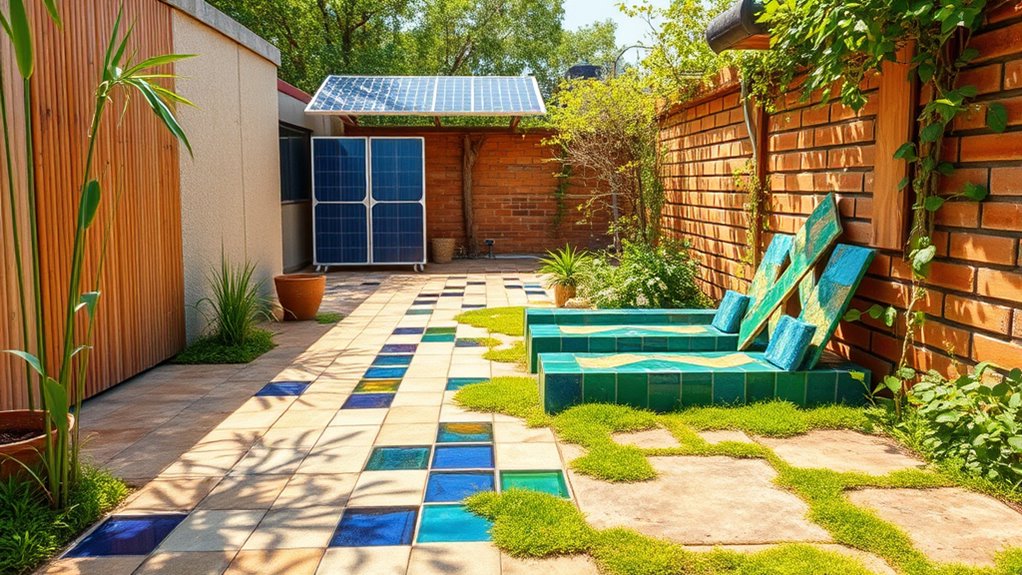
Renewable resources are transforming the construction industry by providing sustainable alternatives to traditional materials. Bamboo, for example, grows rapidly and offers a remarkable strength-to-weight ratio, making it ideal for various applications. Hemp, often utilized as hempcrete, boasts excellent thermal properties and is also rapidly renewable. Additionally, sustainable materials enhance energy-saving capabilities, reducing reliance on non-renewable energy sources. Straw, combined with lime, creates sustainable building materials, while lesser-known resources like sorghum and Bambara groundnut show promise. In addition, mass timber products like cross-laminated timber provide strong structural integrity with a lower carbon footprint. Furthermore, solar energy solutions can significantly reduce the energy costs associated with construction. Regular maintenance of these materials, like proper diet for animals, is essential to ensure longevity and performance. It’s important to consider zoning regulations when selecting materials for your tiny house, as they can impact your design choices. Reclaimed wood reduces waste effectively, and rammed earth uses natural materials for energy-efficient construction.
Sustainable Composites
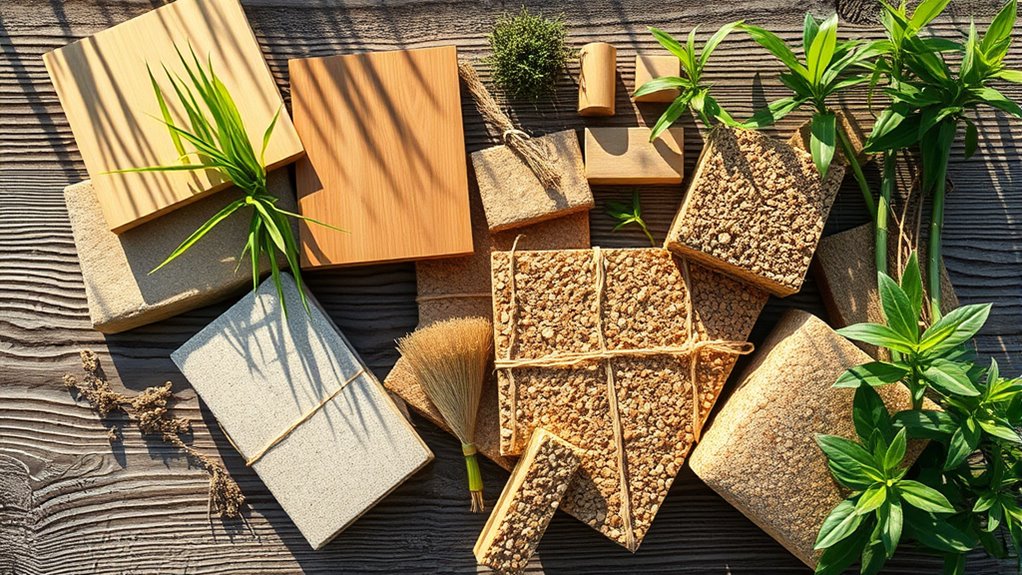
How can sustainable composites reshape the construction landscape?
These innovative materials, made from two or more constituents, offer superior properties through combinations of natural fibers and biodegradable matrices. By using green composites, you can significantly reduce environmental impact, relying on renewable resources and minimizing waste. Their mechanical properties, such as high strength and stiffness, make them ideal for applications like building facades, structural reinforcements, and insulation. Additionally, the use of sustainable composites can help minimize environmental footprint by significantly reducing carbon emissions associated with traditional materials. For instance, modern heat pumps can work efficiently with sustainable composites in building designs that prioritize energy efficiency. The integration of energy-efficient technology enhances the overall sustainability of construction projects. Furthermore, incorporating air purifiers in these eco-friendly buildings can further improve indoor air quality, contributing to the overall health and well-being of occupants. While they may come with higher initial costs, their durability and long life lead to cost-effectiveness over time. Plus, with design flexibility, you can create unique structures tailored to specific needs. Embracing sustainable composites not only enhances your projects but also contributes to a greener future.
Innovative Materials

Sustainable composites set the stage for a new wave of innovative materials that are transforming the construction industry. You’ll find mycelium insulation, which isn’t only stronger than concrete but also fully compostable, alongside mycelium particle boards that replace traditional options with biodegradable alternatives. Decluttering spaces can also be beneficial in construction by creating organized environments that facilitate better decision-making. Mushroom-based panels offer customizable properties for various applications, while plant-based polyurethane foam enhances thermal insulation using renewable resources. Consider sheep’s wool insulation for better moisture control or cork insulation, sustainably harvested for mold resistance. Additionally, pollution-absorbing bricks improve indoor air quality, and cross-laminated timber boasts a high strength-to-weight ratio, making it ideal for seismic zones. These innovative materials are paving the way for a greener, more efficient future in construction, with advanced building systems like Structural Insulation Panels (SIPs) offering enhanced energy efficiency and reducing construction time. Furthermore, the integration of energy-efficient technology in these materials can significantly contribute to sustainability goals in the building sector. In addition, leveraging precious metals investment can provide financial security to fund sustainable building projects.
Bamboo and Its Applications
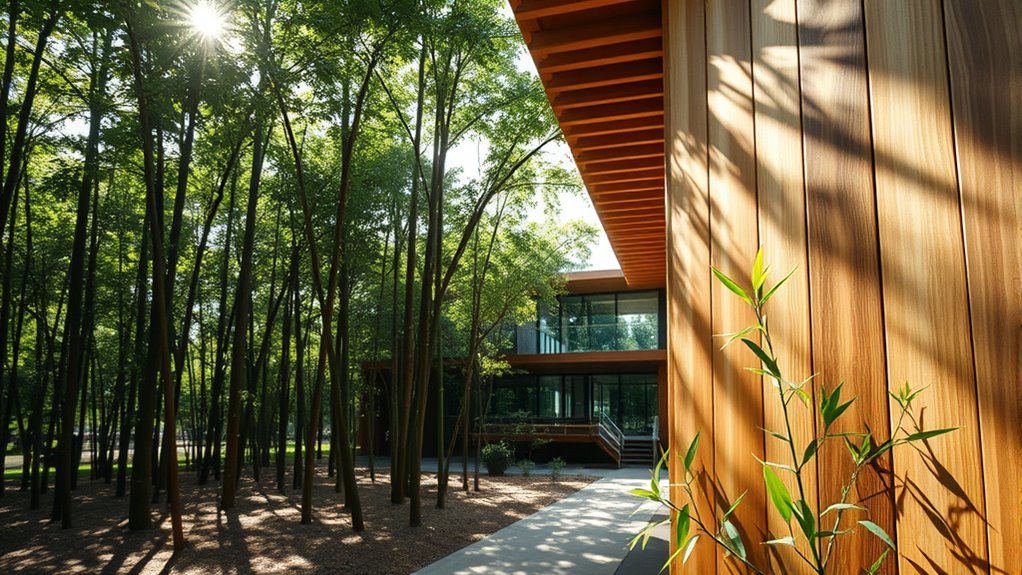
Bamboo stands out as a remarkable building material, thanks to its incredible growth rate and strength. It matures in just three to five years, making it a highly renewable resource. Bamboo can be harvested in just three years, allowing for quick replenishment and reducing pressure on forests. Additionally, bamboo is similar to growing chia seeds indoors, as both require specific conditions for optimal growth.
You’ll appreciate how bamboo absorbs more CO2 than many trees, helping combat climate change. Its impressive strength-to-weight ratio rivals that of steel, and its flexibility allows it to withstand seismic activities, making it perfect for earthquake-prone areas. The use of bamboo in construction aligns with environmental sustainability principles, promoting eco-friendly practices. In fact, using bamboo in construction supports high-performance materials that can enhance overall energy efficiency.
You can find bamboo in various applications, from structural timber for beams and columns to elegant flooring and unique furniture. Additionally, it serves as durable scaffolding for tall structures.
With ongoing innovations, bamboo composites and engineered products are paving the way for even broader usage in construction.
The Role of Hemp in Green Construction

Building on the benefits of renewable materials like bamboo, hemp emerges as another powerful player in green construction. It acts as a carbon sink, absorbing CO₂ during growth and storing it in building materials. With a rapid growth rate, hemp can sequester carbon quickly, promoting sustainability by enhancing soil health and requiring less water and pesticides. Moreover, hemp cultivation promotes healthy soil by encouraging beneficial microorganisms and preventing erosion. Additionally, the use of hemp in construction aligns with renewable energy technologies, furthering the impact of sustainable building practices. Furthermore, sustainable building practices can significantly enhance the overall efficiency of construction projects and reduce long-term costs. Recent advancements in renewable energy sources have also contributed to the feasibility of using hemp in various building applications, making it a more attractive option for eco-conscious builders.
You’ll find hemp in various forms, like hempcrete for walls and hemp insulation that boosts energy efficiency. Not only do hemp-based materials reduce embodied carbon, but they’re also non-toxic and mold-resistant.
Advantages of Recycled Steel
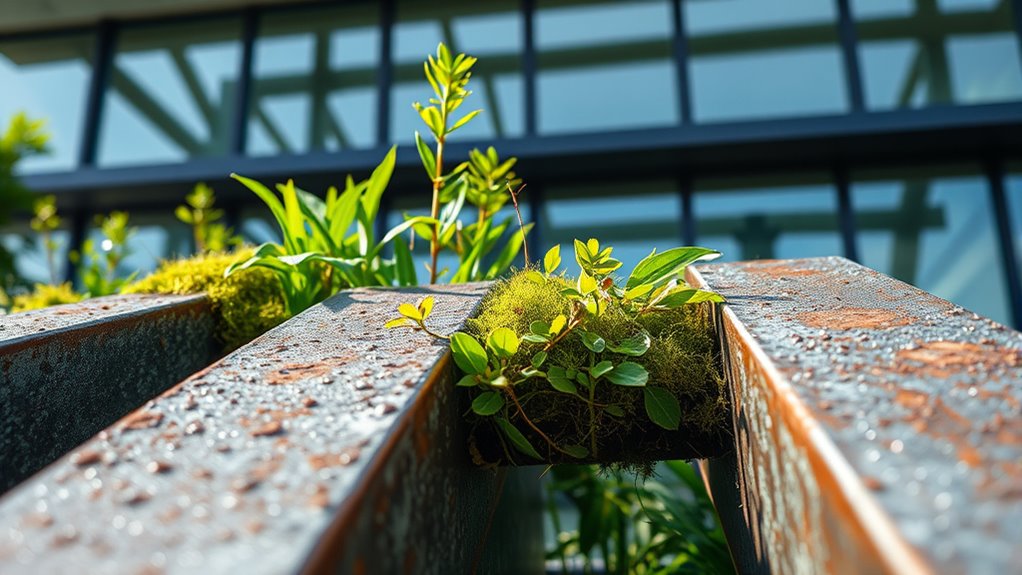
While many materials can contribute to eco-friendly construction, recycled steel stands out for its numerous advantages.
First, using recycled steel drastically reduces carbon emissions, equating to removing over 200 million cars from the road each year. It also saves about 75% energy compared to new steel production, conserving valuable resources like iron ore and coal. Additionally, the recycling process uses 74% less energy compared to producing virgin steel, making it an even more sustainable choice. This aligns with the concept of a closed-loop system, which promotes sustainability through continuous recycling. Moreover, investing in Gold IRAs can provide a hedge against inflation, similar to how recycled steel contributes to resource conservation.
In addition, it’s cost-effective, minimizing construction costs and waste. Recycled steel’s durability ensures structures last for decades while resisting moisture and pests.
Plus, it’s versatile, suitable for various applications. With a high recycling rate, steel promotes a closed-loop system, making it the most recycled material globally.
Mycelium: The Future of Building Materials
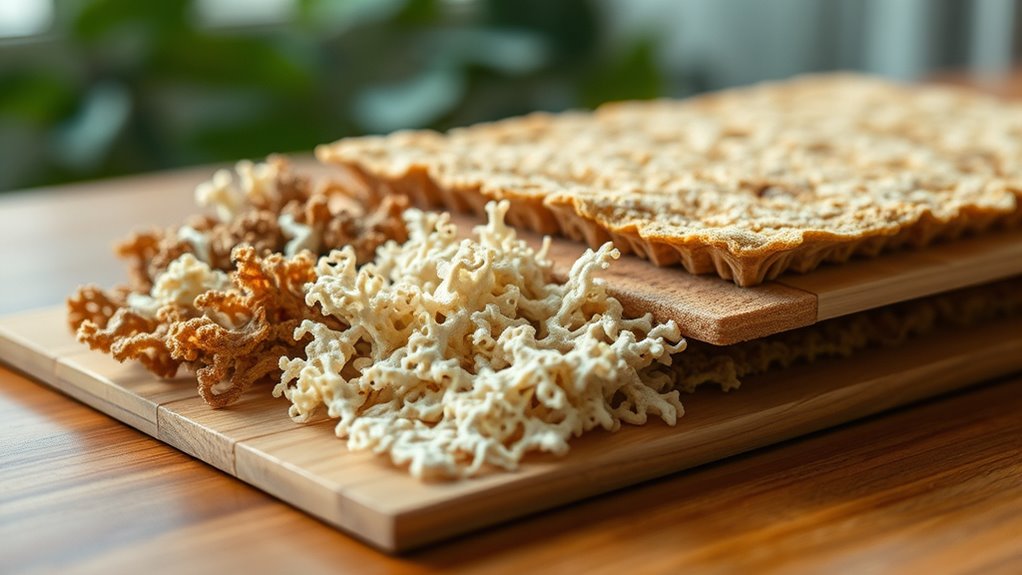
As the demand for sustainable construction materials grows, mycelium emerges as an innovative and eco-friendly option. This biodegradable, carbon-neutral material consists of fungal hyphae that bind organic substrates, creating durable and lightweight building components. Mycelium offers a sustainable alternative to traditional building materials like cement and plastic, which contributes to reducing environmental impact.
Mycelium provides excellent thermal insulation, cutting down energy consumption, and it’s fire-resistant, emitting no toxic fumes when exposed to heat. You can use mycelium for various applications, including insulation panels, bricks, and acoustic panels, helping to improve energy efficiency and sound quality in buildings. Plus, it utilizes agricultural waste, promoting a circular economy. While ongoing research aims to enhance its structural strength and address regulatory challenges, mycelium holds immense potential as a sustainable alternative to traditional construction materials.
Frequently Asked Questions
How Do Green Building Materials Impact Indoor Air Quality?
Green building materials significantly improve indoor air quality by reducing harmful emissions.
When you choose low-VOC paints and natural insulation, you’re minimizing indoor air pollution and regulating humidity.
Recycled products also cut down on waste, while local sourcing lowers transportation emissions.
Incorporating these materials creates a healthier living environment, allowing you to breathe easier and enjoy better overall well-being.
Prioritizing these options ensures a more sustainable and clean indoor atmosphere.
What Are the Costs Associated With Green Building Materials?
When you step into the world of green building materials, you’re walking a tightrope between cost and sustainability.
The costs can vary widely; you’ll find bamboo at around $4 per square foot, while manufactured wood averages $4 to $7.
Though initial expenses might seem daunting, remember that energy savings and potential tax incentives could cushion your investment.
Over time, these materials may not just save the planet, but your wallet too.
How Can I Source Local Green Building Materials?
To source local green building materials, start by researching suppliers in your area.
Visit local construction sites or eco-friendly businesses to discover reclaimed wood, recycled steel, or bamboo.
Establish partnerships with local suppliers to ensure quality and consistency.
Attend community events or workshops focused on sustainable practices, where you can connect with others sharing similar goals.
Collaborating with local businesses not only supports the economy but also reduces transportation emissions significantly.
Are There Certifications for Green Building Materials?
Did you know that certified green building materials can reduce energy use by up to 30%?
Yes, there are several certifications for these materials. Look for labels like FSC, GREENGUARD, or Cradle to Cradle, which indicate adherence to environmental standards.
These certifications assure you that the products you choose are responsibly sourced and contribute to healthier indoor environments.
What Maintenance Do Green Building Materials Require?
Maintaining green building materials involves regular checks and optimizations. You should monitor energy systems to ensure they’re operating efficiently and conduct energy audits periodically.
For water conservation, install low-flow fixtures and check for leaks. Focus on indoor air quality by using non-toxic materials and ensuring good ventilation.
Lastly, select durable, low-maintenance flooring and use microfiber tools for cleaning. These practices help extend the lifespan of materials while promoting sustainability.
Conclusion
Incorporating green building materials is a smart choice for both the environment and your projects. By using plant-based, recycled, and sustainable options, you’re not only reducing your carbon footprint but also creating healthier spaces. Have you considered how your building choices impact the planet? Embracing materials like bamboo, hemp, and mycelium can lead to innovative solutions that push the boundaries of construction. Let’s build a greener future together, one sustainable choice at a time.
